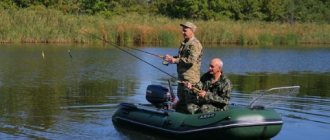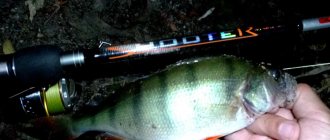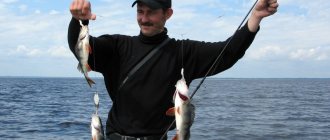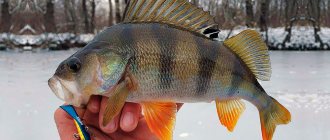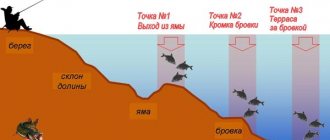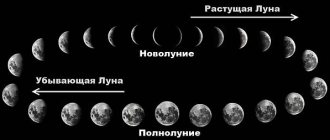Winter fishing in February in central Russia means fishing in the middle of nowhere. There is minimal oxygen in the water, the fish is sleepy and tired. However, thanks to the perch, you can still get pleasure from fishing. Let’s figure out what’s special about perch fishing in February, what gear is needed for perch fishing in February, and what is more successful for perch fishing in winter. For novice fishermen, we will tell you what is good about catching perch in February with a jig and how to catch perch in winter with a spoon.
Perch is a fish known to every fisherman due to its prevalence: in rivers and streams, lakes and ponds, perch is found in abundance. This small fish, weighing from 80 to 150 grams, has a length of about 20 cm. In reservoirs you can catch larger perch weighing 500 - 700 grams.
Perch fishing in February can be quite fruitful. Indeed, with the first thaw in February, perches gradually emerge from their half-asleep state and begin to feed again, therefore the perch bite intensifies in February.
Behavior and biting of perch in February
February is a difficult period for representatives of the ichthyofauna, including perch. But unlike the others, the striped predator retains a certain activity; it is much easier to interest it by offering interesting bait. Therefore, perch fishing is popular among anglers in February.
At the beginning of the month, the predator is weakly active, and at the end of February, perch fishing becomes more active due to thaws.
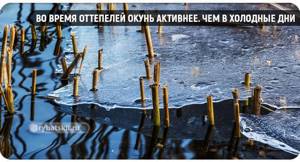
Thaw affects the bite
In the first days of the month, when the ice is still strong, due to the low concentration of oxygen, the fish become lethargic, passive, and rarely leave their wintering pits. This is especially pronounced in small reservoirs and lakes. Locations of perch can be identified near warm springs and tributaries. The predator avoids shallow areas of the reservoir with muddy water.
In search of food, it moves more actively in rivers, where water flows circulate better. Fishing will also be effective in reservoirs with great depths. It is more likely to catch a large perch in mid-to-late February, when the ice begins to “weaken.” It is much easier to search for it; it does not concentrate at one point, but is scattered throughout the entire reservoir.
In February, perch is most active on large rivers with strong undercurrents. Classic fishing takes place using jig tackle and the principle of trolling.
Going out hunting when weather conditions change is not very effective; perch reacts poorly to any type of bait. The mining activity will be during a stable period. The striped predator feels normal in light frosts down to -10 °C, with stable pressure and a light breeze.

Tackle and bait
In February, a variety of fishing rods are used to fish for active predators, from a regular balalaika to a winter spinning rod. It is generally accepted that at the junction of winter and spring, perch responds better to small baits in natural and dark colors, but in practice anything can happen. In some reservoirs, a completely opposite picture is observed: the brighter and larger the bait, the better the bite.
What to do if the perch doesn’t bite at all? The passive predator requires very delicate, sensitive gear and miniature baits. Experienced fishermen who know how to properly set up their gear and select catchy bait always return home with a catch. Moreover, jig-fishers (including non-reelers), spinners, and supporters of balda fishing are equally successful.
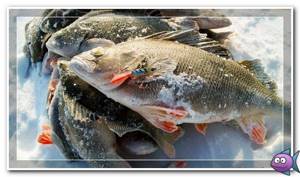
Catching perch with jigs
The easiest way to seduce February perch is with a jig and bloodworm. When fishing at great depths, you should give preference to heavy tungsten jigs, which sink faster into the bottom horizon, where the striped predator usually stands. If there is more than 7-8 meters from the hole to the bottom, then small spinners with one hook are used, on which a bloodworm is also attached. The tactics for fishing with a jig with bloodworms are simple. First, several holes are drilled in a promising location, and then they are fished one by one. If the striped one does not respond, you can move on.
You can also stir up the striped robber in February using a no-attachment jig. This is not an easy task, because this predator loves aggressive play, but in the first half of the month it is still passive, saving energy. To seduce him with a mothless, you need to try very hard. Small dark jigs decorated with beads work best for February perch. The color of the “decoration” is selected experimentally. If the fish behaves sluggishly, bites cautiously, hesitantly, you should try a smooth, low-amplitude retrieve. Techniques such as tapping a jig on the ground, slowly pulling (as far as the width of the hole allows), hovering the bait above the bottom at a height of no more than 2 cm, and various swarming movements can be effective.

Catching perch with spoons and balancers
Are spinners and balancers effective in February? An avid spinner will smile slyly in response to such a question. Of course it bites, sometimes even better than with a jig. But only those who know the reservoir well and its features, master various fishing techniques, know how to select the key to passive fish and “swing” perch points. In this case, the tackle should be as sensitive as possible, with a nod that registers the weakest pokes. Small balancers and spinners are used, which must be played more smoothly than on the first ice in December. The hooks of the baits are decorated with a tuft of brightly colored wool to make them more attractive. Some fishermen successfully use the so-called Finnish rig. They remove the treble and instead hang a single hook with red wool or a bright fly on a short fluorocarbon leader (no more than 3 cm). In most cases, the striped fish grabs precisely this provocative element, and not the bait itself.
At the end of February, awakened perch can also be effectively caught with a worm. The equipment for such fishing is reminiscent of the equipment of a summer fly rod. It is assembled according to the same principle: main line - lead sinker - pellet - leash - hook. The only difference is the absence of a float; its function is performed by a nod. Several fishing rods are placed at once in a promising place, after which all that remains is to sit comfortably on the fishing box and watch the guards.
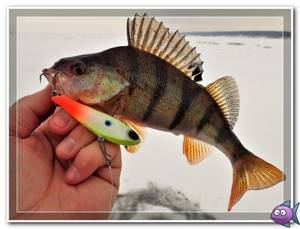
Where to look for perch in February
You can expect a perch bite in February in any horizon, except for places that are too deep and areas with strong currents. At the beginning of the month, permanent winter camp sites for the predator will be promising, and at the end, shallow water areas should be fished.
Look for perch on the river:
- in places with weak currents;
- in the creeks;
- on the bays;
- in thickets of coastal vegetation.
In reservoirs, fishing success is possible in the flooded floodplain. The riverbed attracts little perch; there is not only great depth and few places for shelter, but also poor visibility. Flooded river valleys benefit greatly due to the abundance of food supply and secluded places; the striped predator is found here much more often. It is attracted to places near flooded barges and concrete structures. Good results are observed at the pier and the edge of the embankment.

You can catch perch in February both on the lake and on small rivers. If the lake is deep-water, then the perch disperses throughout the reservoir . In small water areas, areas with shallow depths, up to 2-3 meters, and thickets will work. On small rivers it is better to hunt in the deepest areas, under overhanging trees and bushes. Returns, edges, and exits from pits will also be promising. Perch bites are also possible on peat bogs, where it attracts anglers with its size and bright color. If you catch a small perch, it will be bait for pike.
Read more about catching perch in the wilderness.
Search for a predator
Throughout the month, the tactics of searching for perch changes. In the early days, there will be a greater chance of finding this fish at depth, in its winter resting places: in deep-sea areas with a hard and uneven bottom surface, on channel edges and dumps, in flooded snags. It should be taken into account that the perch will not stand in a strong current, so you need to drill holes not on the stream itself, but next to it. The predator's favorite places during the deep winter are considered to be the return paths and boundaries of multidirectional currents.
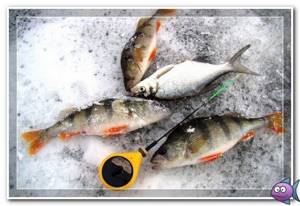
As spring approaches, schools of perch begin to leave their winter camps and move to the coastal zone, to sandy (rocky) spits and rifts, where small forage fish concentrate in the second half of February. It is the abundance of food that attracts perch here, which needs to gain strength before spawning. In addition, in shallow water, among the remnants of last year’s vegetation, living creatures living in the ground, which are part of the predator’s diet, have already awakened. Adults try to avoid swampy places where vegetation continues to rot, but here you can always find small perches one or two years old and enjoy sport fishing on a catch-and-release basis. They can also be used as live bait to catch other predators.
In February, perch bites well on small rivers. Of course, it’s unlikely that you’ll be able to get a mountain of fish from one hole on narrow rivers, but bites are guaranteed here. In such reservoirs, striped robbers gather in small groups (several individuals), so after catching 2-3 heads and stopping the bites, you can confidently move to another promising place. On the small river in February you should look for perch:
- in places with reverse flow;
- in areas with abnormal bottom relief;
- behind the rifts;
- at the entrances and exits of pits;
- next to trees that have fallen into the water.
On small lakes and ponds where there is an acute lack of oxygen, perch is not particularly active. In such reservoirs, the predator falls into a state of torpor and becomes active only after the ice melts. Fans of winter fishing know that attempts to catch lake or pond perch at this time of year most often end in failure.
Choosing the best bait
Among the catchable baits for February perch are:
- maggot;
- larvae;
- worms;
- bloodworm;
- pieces of meat/fish fillet;
- chicken/fish offal.
Perch reacts better to live bait caught from the reservoir in which hunting is planned.
It is often possible to attract the attention of a striped predator using a jig with bait. Models with body size up to 4 mm work great. Jigs have proven themselves well when catching passive fish.
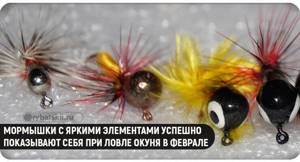
Perch bites better in February on bright jigs
Improve the bait using rings made of colored insulation and red woolen threads. Lead models are painted red (tip) and black (shank of the hook). For greater efficiency, bloodworms are attached to the jig. For perch, you should choose a pellet or a drop.
In winter, the models of spinners with a size of 2–5 cm are catchy. It is better to use a matte color; effective options would be spinners in black, copper, as well as in gold and silver. A pendant on a hook works as a provoking factor.
Flashing
There can be a variety of fishing rods for this type of fishing, but they must have a reel. You also need to choose a long whip to make it more convenient to play the lure. Fishing for perch in February involves fishing line with a diameter ranging from 0.15 to 0.2 millimeters, preferably in two colors: brown for large specimens and green for smaller ones. It is better to use a 70-130 mm nod, made of a polymer plate, to ensure smooth play.
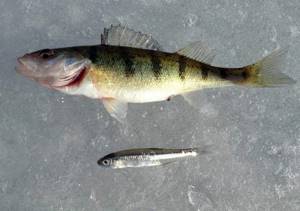
Tackle for perch in winter - a spinner or a balancer - you can take a variety of different ones. In this case, it is necessary to take into account the specifics of this reservoir. Bright lures work well in one, and dark lures in the other. With the right choice and the right game, even the most passive predator will not resist the temptation to swallow the bait.
February fishing tactics
To make perch fishing in February exciting and productive, use the tactics of circular fishing of holes. It is recommended to make 5–20 holes in the ice and go around each one in a circle. This technique involves fishing from the first to the last hole, then entering the second and subsequent rounds. If there are no bites or there are few of them, then the location is changed.
Another option for hunting a striped predator in February is to fish several holes and then move to another territory. Those points that have already been worked out are no longer taken into development.
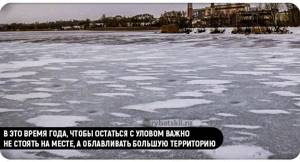
Try to fish most of the lake or river
If the perch does not respond to the offered bait within 5 minutes, then it is better to change the fishing point. Only with an active search will the chances of catching a striped predator be high.
When using jigs, spinners and balancers in February, you should choose a standard wiring technique. It is better to serve the bait smoothly, leisurely, without sudden movements .
What to catch perch in February
To catch a striped predator use:
- winter fishing rod when trolling using the vertical method;
- a fishing rod for jig hunting with a guard;
- the usual version of winter float gear.
It is good to use a small reelless fishing rod for February perch. The whip on the predator is made elastic so that there is proper shock absorption when hooking.
Attachment jigs
You should catch perch in February with a jig using a small winter fishing rod equipped with a signaling device such as a guard or a nod. The bait itself is a small hook, which is soldered into a metal alloy of a drop-shaped, round or other shape, equipped with a hole for tying a fishing line.
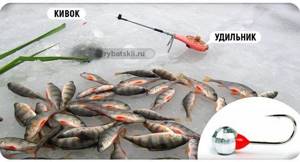
In order for a jig to attract perch, it must play, creating short, high-frequency vibrations. You can move the bait both up and down, taking pauses between these manipulations.
Jig technique:
- The bait with bloodworm bait is first immersed to the bottom, then raised 2 cm from it, and lifted. Pauses are made every 5 cm, accompanied by a smooth swing of the jig. When the bait is 60 cm from the bottom surface, the rise is stopped and it is lowered again.
- Having lowered the jig to the bottom, make small lifts from the bottom (1 cm). This way you can get the bait to move. Every 4 such cycles, a stop for 6 seconds is required, while the jig is either at the bottom or near it. There is no need to make any sudden movements here, everything is done smoothly.
It’s not for nothing that a baited jig is considered one of the most popular tackles for perch. It is often used in competitions. It catches both small and large predators. Efficient models made of tungsten. Despite their size, they are capable of fishing to depths of up to 8 meters. The fishing line used for it is 0.1-0.12 mm thick.
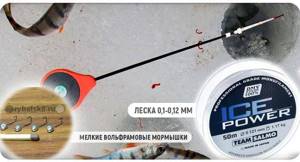
Nozzleless
Baitless fishing also brings results. Unlike attachment jigs, they are heavier. They can be used without a nozzle or using spongy flavored rubber or edible silicone. Catchable, dark, small-sized mothless moths. The color of the beads that are attached to the hook is selected by sampling, experimenting with shades.
The reelless devil behaves excellently on perch in February. Due to its heavy weight, this lead invention with a soldered hook has sufficient stability when playing at a depth of 2–3 meters.
Drilling a hole.
Even taking into account all the features of the terrain and weather, you need to drill more than one or even two holes. A successful hole begins to collapse from the first minutes. But if the perch does not collapse and the bait does not help, the fisherman risks sitting for quite a long time without results, so the best option would be to move to another ice hole.
Fishing gear.
For the most part, three types of fishing rods are used for perch in winter, such as: • A fishing rod suitable for vertical trolling • A jig fishing rod with a bloodworm attached • A regular winter float fishing rod The easiest way to catch a perch is with a jig with a guard! In deep water, it is best to use heavy tungsten baits. The fishing line is usually selected the thinnest 0.08-0.12 mm. The thinner the fishing line is chosen, the more bites you will get.
Advice! The rod should be selected based on depreciation. A thin whip 10-15 cm long will help protect against breakage.
Fishing technique.
In February, perch are most likely to bite on miniature vertical jigs with a hook height of five to seven millimeters and a diameter of no more than 4 millimeters.
Advice! To attract interest, some also use red wool or rings of colored insulation.
The method of fishing with a jig is one of the most common; when fishing with bait, the bait should be lowered closer to the bottom at small intervals at a distance of a couple of centimeters with a smooth sway. In this case, initially it is advisable to lightly hit the bait on the bottom to create the effect of swarming small fish, thereby greatly interest- ing the perch.
Next, you should slowly raise the bait, but you should know that large perch usually do not immediately rush to prey. If an individual fails, you can immediately move to another hole, since in the next half hour you can’t expect any fish in the hole.
Despite the difficult weather conditions, fishing for perch at the end of winter is no less interesting than at any other, warmer time of the year. Fishing in February frosts gives fishermen a chance to catch large trophy prey and get an unforgettable experience.
Have you had experience in catching perch at this time of year, tell us about your methods and secrets in the comments! Like, share with friends and join our channel “your blog, group” if you want to keep abreast of events in the field of fishing!
Happy fishing!
